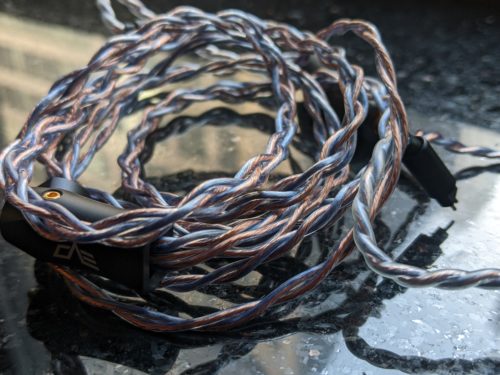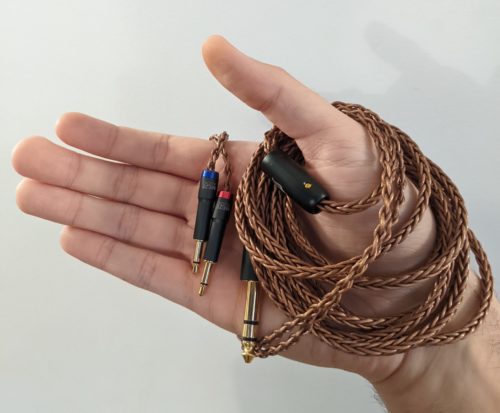Do Headphone Cables Matter?
“Grab the silver cable to record this part, I want an extended high end,” is something I have never heard said by a recording engineer. In fact, it’s precisely the sort of statement that has self-proclaimed “audiophiles” drawing laughter from studio engineers. At the end of the day, there are cables that get talked a lot about in professional studio environments: power cables. Those are indeed far more important to overall sound quality as they have significant effects on noise floor and, depending on how much power we’re talking about, electrical interference. But we won’t be getting too deep into that in this article. We’ll be focusing on whether or not there are any notable differences between different audio cable materials.
Short Answer: NO – Not For Tone, At Least
If you’re reading this, I’m sure you’ve read this before: copper produces a warm sound, silver produces a bright sound. This is a topic as tired as it is controversial, and while my view on this is hopefully more nuanced than it may first appear, I will be forward about what I really think: until there is a shred of decent empirical evidence about claims like this, looking at cables like this is mostly audiophile kool aid – or worse yet, cable company snake oil.
The back and forth on this topic is seemingly endless but I like to keep it short with this video here, which is kept simple, and goes to show that 1) There are maybe differences between cables and 2) Those differences are so minuscule that they are insignificant so far as psychoacoustics are concerned – as the speaker himself notes, those differences may even be due to the margin of error within his testing methods. It is frankly more compelling than listening to story time from a guy talking about how a specific cable made vocal air sound raspier (I don’t want to name names, but yes, that video is real and has too many views).
“But I hear the difference! Just because the science isn’t there to prove it yet doesn’t mean it’s not true!”
Well, I went headfirst into trying to hear this difference that people swear by. I must have tried ten different cable and headphone pairings before writing this – gold, silver, copper, litz variations, silver plated on IEMs, over ears, high and low resistance – you name it, I tried it. I like to think I have pretty analytical ears that get a lot of exercise, but I can tell you definitively that I heard absolutely no difference. There’s more to be said about this, so I’ll come back to it a little later.
Perhaps some people who read that smirked knowingly, proud of their “golden ears” for hearing the difference between their $3000 gold cable and their $70 copper threaded. Again, this is a topic that can be its own article, but having real “golden ears,” that is, being able to correctly identify tiny changes to extremely narrow portions of the frequency spectrum, basically means you have perfect pitch. I have to say, there’s a lot of people these days claiming to belong to the verified .01% of the population with such an ability. What’s more likely is that companies need a devoted customer base to think that they’re hearing microscopic differences to justify some of their obscenely priced cables. The key here is to not just tell people what they enjoy (Gold-Silver-Diamond-Plated-Copper-Balenciaga cables), but how to enjoy it (by being a part of an exclusive of group of music hobbyists with “golden ears”).

Some Properties That Actually Matter In Headphone Cables
Everything I’ve written so far isn’t to say all cables are created equally – there are certainly build and material qualities worth considering. Luckily for everyone, these factors are fairly simple and easy to understand. Please note: I am not including conductivity on this list. While this property is relevant in other electrical circuitry, the differences are simply not vast enough to make much of a difference in audio signal transmission at short or even medium distances.
Malleability
Malleability is a material’s ability to bend without breaking. It’s easy enough to imagine why this can be an important consideration for the wiring material: perhaps you tightly curl your cables, or just generally put them through backpack hell, and worry about snaps and breaks. Gold, silver and copper are all malleable metals, and the most common materials used in headphone cables. Gold is the most malleable, followed by silver, and in fourth place behind aluminum is copper. So while this quality does bare significance, you can rest assured: whatever cable you’re getting is more than likely wired with a very malleable metal. But if you really want to make sure the wiring in your cable is as malleable as possible, the order of preference is simple: gold, then silver, then copper.
Rust and Corrosion Resistance
You’ve probably heard a rusty cable before, even if you didn’t know exactly what was wrong with it. Rust disrupts and corrupts audio signals over time as the conductive material responsible for transmitting the signal slowly transforms into an altogether new, non-conductive material through the process of oxidization. Rusty cables can sound crackly, distorted, or just straight up cut in and out. They detract from malleability and create brittle points in cables that are liable to snap. No golden ears needed! Anyone with a normal old pair of ears would be able to tell that something is seriously off with a rusty audio cable. Out of the common metals used in headphone cables, gold would once again be the go to material in terms of rust and corrosion resistance. Copper is a more reactive metal than gold or silver but is nonetheless still fairly resistant to rust or tarnishing. The order of preference in this category is, once again, in descending order: gold, silver, then copper.
Insulation and Build
This is a little more general than the other two considerations I’ve listed, but equally as (if not more) important. In some ways, it’s intuitive: how does the external wire casing feel? Does it feel cheap and plasticky, like it can be cut with a fingernail? Or does it feel strong and thick enough to withstand being your cat’s new chew toy? Another important factor in build that can’t really be tested (except with long term use) is how well the wiring in the cable is soldered to its connection points in the headphone jack. Even a cable made of the finest gold in the world will break fairly easily and quickly if the wiring and jack have been poorly soldered (this is a criticism I often read about the prolific snake-oil instrument cable company Mogami). As I obviously don’t recommend trying to crack open the jack on your headphone cable to check this, this is a quality that matters quite a bit but that can’t be known until you’ve accumulated some personal experience with a variety of cable manufacturers.

Non Technical Factors: The Sublime Joy Of Selecting A Cable
Even as an ardent skeptic in the cable debate, there’s a psychological component to all of this that goes beyond a binary of believing or not believing. I’ve recently been doing a lot of listening with the iKKO Asgard OH5, but found the cable that comes with it a little too short for my commutes, and thus switched it out for a longer one. Now, I hear no difference between the cables, but I hold onto the original iKKO cable and use it when I get home.
Why?
Because I like it. There’s a sublime satisfaction in knowing that it’s a special silver plated cable, of seeing the silver through the thick and transparent plastic sleeve, “pairing” the silver with the rare lithium that I know to be in this IEM’s driver. It’s fun, and reminds me of putting a new Pokemon card into a card binder when I was younger and then ogling over my collection.
This makes me think of people who set out to create technically advanced and rare HiFi set ups in their own homes. While I’m dubious of any qualitative audio claims they may make about cabling, I suspect that the real heart of their satisfaction comes from the principle of their design choices rather than the final result. There’s a term for this kind of enjoyment in Lacanian psychoanalysis, “Jouissance.” It can be summarized as enjoying the pursuit of an ideal more than the ideal itself, which frankly, I respect and see as a characteristic that makes a hobby fun and worthwhile.
Tactile and aesthetic considerations also shouldn’t be underestimated. Music studios, for example, will put plenty of effort into the non acoustic elements of their studios because it’s no secret that everything effects how one perceives sound – right down to the color of the couch. In the process of cable testing, I found I really liked the Copper PCUHD Premium Cable from Meze Audio. As I stated before, it’s not because I heard any audible difference, but rather because I liked the warm, woody-brown coloring; I liked the weight of it in my hand, and the smooth, sturdy texture. In my mind, something about it was conducive to thinking about the audio signal it contained as being fluid and full…even if it sounded exactly the same as any other cable I tried.
Conclusion
The science, nor my ears, are on the side of those who say they hear noticeable differences between headphone cables. When you’re considering a cable, your top priorities should be physical considerations like the ones described earlier, and honestly, even more importantly, basic personal preferences such as length and susceptibility to tangling. Don’t be embarrassed to choose a cable just because you spontaneously like its look and feel: your brain might tell the difference, even if your ears can’t.
Get whatever frickin’ cable you want from Audio46.
Compare the ranking of various headphones, earbuds and in-ear monitors using our tools.
Discuss this, and much more, over on our forum.
---MAJORHIFI may receive commissions from retail offers.















